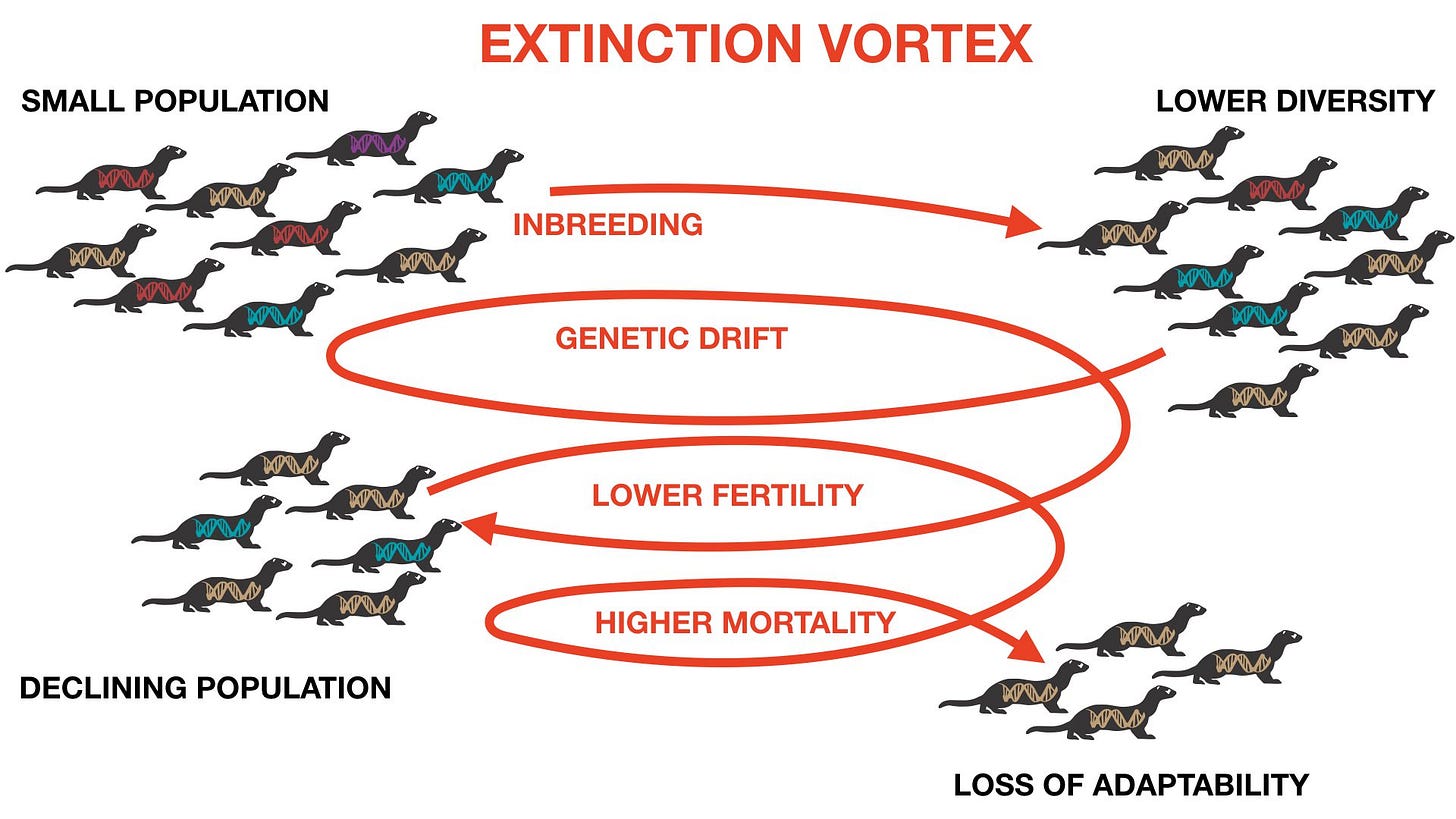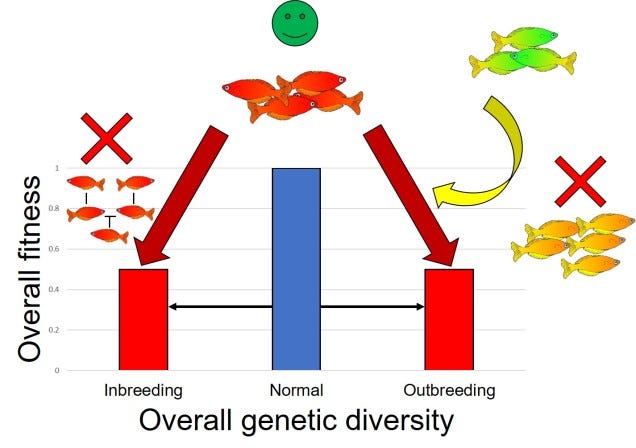In this epoch of globalization, the geographic and cultural barriers which once separated human populations have evaporated by a substantial degree. In turn, the frequency in which individuals of different nationalities and ethnicities decide to reproduce (specifically in 1st World nations, where the aforementioned barriers are substantially weaker) is skyrocketing. Just in the last decade, the US’s population of mixed race individuals has risen 276%.
The reaction to this development has been far more than neutral, rather it has been met with boisterous applause from both our global & national elites and their institutions. Take this quote from a CNN article on interracial marriages, for example:
As long as there is little contact between White and non-White Americans in those settings, the power of personal experience to dissolve prejudice will remain moot. Unless there are more personal relationships between White people, Black people and others in those spaces, we will continue to live with [racism].
Downstream of this and the ebb of a transformed society, support for interracial marriages in the US has flipped from 4% in the 60’s to 94% in 2021. One of the most iconic demonstrations of this attitude came from a 2013 National Geographic publication which started the viral image of “What the average human will look like by 2050”.
Aside from a cultural standpoint of “ending racism”, interracial relationships and a generally positive attitude to the indifferentiable mixing of cultures have been promoted through pseudoscientific rhetoric involving population genetics. The findings of this field have long (and correctly) indicated that, within populations, a degree of genetic diversity provides a beneficial weapon against extinctions. In the most frequent example of a viral pandemic which strikes a species, a uniform population risks a complete extinction, while a population with pockets of diverse subpopulations will likely make it out with 30%. In essence, diversity provides an array of tools/weapons in the arms race of evolution, which can be selected for in any type of calamity.
This observation of course also includes the handful of deleterious effects from inbreeding, which need little review. But in context of population genetics, one commonly cited downside of lower diversity is an “extinction vortex”. When one such calamity presents itself to a population, it is likely that one subpopulation fairs better than the mean. Their survival and the death of other subpopulations results in decreased diversity within the population at large, and therefore, more inbreeding. This quickly spirals into the “vortex”, where each effect from the previous event decreases a population’s resiliency.
The causeway into using this was a promotion for diversity as a sociopolitical concept (i.e., mass immigration) becomes apparent. Diversity, we’re told, gives us wider array of experiences to utilize in politics and in the workforce. Diverse communities, we’re told, are more likely to cooperate and progress, leaving behind isolated nations like North Korea.
Of course, this argument starts off as a red herring. Humans or any specific subpopulation of us aren’t experiencing any sort of extinction or decline, quite the opposite. Nor does it have a problem with inbreeding, at least outside of the Islamic world. But most importantly, it obfuscates the danger as a unidirectional phenomenon. “More diversity is always good, and the furthest from inbreeding is always better.” This couldn’t be more wrong, because it leaves out its partner in population genetics: outbreeding depression.
As it turns out, reproducing with someone too distant from your own genome produces a number of deleterious effects - not just on the scale of the health of individual offspring, but wide-spanning effects on societies which adopt a general approval of miscegenation at large. This isn’t a long-forgotten theory of the 20th Century, in fact it is still used today in population genetics. Just to illustrate its commonplace and contemporary use: when selecting for individuals to help a related, near-extinct population recover, great care is taken to ensure that the selected individuals do not incur some type of harmful or deleterious effect on their reproductive fitness. This concept has seen implementation in the reintroduction of endangered species, such as red wolves in North Carolina.
As populations become increasingly fragmented, managers are often faced with the dilemma that intentional hybridization might save a population from inbreeding depression but it might also induce outbreeding depression. While empirical evidence for inbreeding depression is vastly greater than that for outbreeding depression, the available data suggest that risks of outbreeding, particularly in the second generation, are on par with the risks of inbreeding. (Edmans 2007, linked above)
What exactly are these effects? The clearest marker that something is awry with a population or individual is a decrease in reproductive fitness, essentially, how successful you are at reproducing and how likely your genes are to survive in perpetuity. Actions which render you or your descendants as sterile is, by definition, a reproductive fitness of 0. Actions which increase your success or the success of your descendants will be selected for by the evolutionary process. The production of first-generation (F1) sterile hybrids, such as a mule, is indeed a clear example of outbreeding depression. An individual has mated and reproduced with another individual exceedingly different from itself, and its offspring has suffered a total collapse in reproductive fitness in the form of sterility.
But humans are not mating with congeneric species, but rather individuals of their own species. On an ecological scale, the genetic distance between these individuals are not that vast, and obviously mixed-race children are not sterile. However, a distance indeed there is, and we do still see the effects in reproductive fitness.
Take for example this large cohort of Danish women born in 1954, comparing the number of children they had with the geographic distance between them and their husbands, showing a clear initial rise (away from inbreeding) followed by a gradual decline after a peak (into outbreeding).
Interesting, but it doesn’t tell us much about kinship or genetics outside the fair assumption that radius correlates to it. Luckily, another exceptional study of Icelandic families in 2008 compared the kinship of parents to how many children they had, finding:
Our results, drawn from all known couples of the Icelandic population born between 1800 and 1965, show a significant positive association between kinship and fertility, with the greatest reproductive success observed for couples related at the level of third and fourth cousins. Owing to the relative socioeconomic homogeneity of Icelanders, and the observation of highly significant differences in the fertility of couples separated by very fine intervals of kinship, we conclude that this association is likely to have a biological basis. (Helgason et al. 2008)

What’s most notable about this study is that Icelanders are notoriously homogenous, both socially and genetically. If we can confidently observe a reduction of fitness at the level of 1st to 8th cousins, what should we conclude about even more distant pairs between individuals whose ethnic groups have been isolated from one another for tens of thousands of years? Again, outbreeding depression has appeared to have nestled itself in human populations:
[P]ast-year fertility rates among interracial couples were, on average, significantly lower than among racially endogamous couples. This is especially evident among married couples rather than among cohabiting unions, which had depressed rates of past-year fertility. Rising cohabitation, especially among interracial couples, clearly places downward pressure on fertility rates nationally. Low fertility rates among interracial cohabiting couples also suggest that interracial couples may choose cohabitation rather than marriage as a response to stigma. With continuing increases in interracial cohabitation (Sassler & Lichter, 2020), there is little likelihood that today’s unprecedented low fertility rates are likely to rebound anytime soon. Choi and Goldberg (2020) claim that fertility patterns among interracial couples have cultural meanings; acceptance of interracial couples promotes commitment and transitions to a marriage and provides a more stable context for childbearing. (Qian and Lichter, 2021)
As a quick note, it is an interesting revelation that, deep in the scientific literature shadowed over by political narratives such as “we need immigration to fix our birth rates” or “diversity is our greatest strength”, miscegenation may actually be a significant contributor to the collapsing fertility rates of Western countries, though probably not its primary driver:
Another possible biological explanation relates to population mixing: during the 20th century in the developed world, with urbanization and improvements in transport, it became increasingly likely that couples would be from distant populations both spatially and genetically, rather than from the same or a nearby village or urban neighbourhood. This would be expected to result in hybrid vigour. Both this hypothesis and the effect of diffusing knowledge could readily be studied by incorporating them into the type of TTP study described above. (Joffe, 2010)
On the level of individuals, we have reached the point where we are able to identify specific deleterious mutations which are exacerbated by outbreeding depression, indicating that the long-reported negative health outcomes of mixed individuals is perhaps substantially more than psychological trauma or systemic racism. ADAMTS13 is the first, and surely not the only and last gene to fall under this rule. More will come - if scientists are permitted to study.
ADAMTS13 autoimmunity as a result of increased inter-allelic diversity represents the first example of genetic out-breeding depression in humans. As autoantigens in general seem to have increased numbers of SNPs, increased inter-allelic diversity may represent an important pathophysiological feature in other autoimmune disorders as well. (Meyers et. al, 2007)

Humans are not exempt from the laws of nature. We possess the same fundamental makeup as every other mammal, every other eukaryote in this case, and are in turn subject to the same general observations we see in the natural world. Outbreeding depression is certainly no exception.
Seemingly everyone alive in the West is correctly attached to the cultural more that inbreeding is bad. Centuries of efforts to reduce the occurrence of it and educate individuals of the harms worked, and much to our benefit. But on the other end of the stick where outbreeding depression is found, there is near-total silence.
Maybe worse than that, there is obfuscation and misdirection - there is pseudoscience - that interethnic mixing, interracial marriages, and increased diversity are absolute goods with no consequences. As a matter of fact, the current literature is quite clear that outbreeding depression poses just as much of a risk as inbreeding. Perhaps for our time, where inbreeding is absent in the West and outbreeding is widespread, it should be argued to pose a significantly larger risk to the genetic health of our population. It’s easy to mock the Habsburg Chin, but do you have the courage to mock American sex tourists in Thailand?
Like every other “inconvenience” of genetics, it is unlikely that the findings of the research presented here will ever find its way into the mainstream. The West has decidedly chose the opposing narrative, and therefore avoiding the genetic damages and decreased fertility from mass immigration will have to be fought on some other battlefield with some other argument.
But this need not affect your genetic health and the upbringing of your descendants. Trust the science. Marry your 3rd or 4th cousin.
By nature we have no defect that could not become a strength, no strength that could not become a defect.
Goethe








Used the article to try to redpill a normie on IG, (im too lazy to argue them myself lol) and they responded with this. Your thoughts?
Some, likely the substantial majority of the “rise” in the multiracial population is just the same people reporting as multiracial where before they reported as one race. The increase recorded is +24 million from 2010 to 2020.
In 2015, 14% of US newborns had parents of differing races (of which half were the white-hispanic combo). There are roughly 3.5 million children born every year in the US, so roughly 500k multi-racial annually. So only about 20% of the “rise” from 2010 to 2020 is new humans.
Some of the rise too is likely immigration, but it’s not plausibly a significant portion.